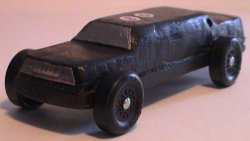Last year was my son's first pinewood derby. He didn't know what to make, and at the time I didn't have an Avalanche, but knew I wanted one. He had an Avalanche RC car, so we decided to make an Avalanche since I liked them and we had a good model to go by.
This year the shape of the car was totally up to him - I let him do a lot more of the work himself. I operated the table saw and drill but let him use the dremel some. I'll have to take some pictures when I get home of his 2 cars so I can post them here.
We didn't put as much time obviously into the finish of the car as you did. However, this year my son took first place in his pack. Our secret to speed - max weight, placed as far to the rear of the car as reasonably possible. The track my son's pack uses goes down for its first third, maybe less, then runs level to the finish line. Weight at the rear of the car has farther to drop than weight in the front, so the weight in the rear of the car has more stored energy to turn into speed than in the front.
I assemble golf clubs from components that I purchase from Golfsmith, and because of that, I have an electronic scale that reads ounces to hundredths (compared to the pack's scale that reads to the tenths). After my son pretty much had his car the way he wanted it, I weighed it to see how much weight we needed to add. It weighed about 3 and a third ounces, so we needed to add about 1 and 2/3 ounces to max out at the weight limit. Golfsmith sells most of their club heads these days on the light side, but has what they call "weight ports" where weight can be added to bring the weight of the club head up to where the builder wants it. They sell a variety of lead and tungsten weights weighing from 2.5 to 9 grams. I drilled 9 holes in the back end of his car (you'll be able to see when I post pictures) and let the weights stick out far enough to look like exhaust pipes or maybe rocket motors, as well as to reach out to the max length limit of the car. We re-weighed the car, and it measured 5.01 ounces, with the 1 bouncing back and forth to 0. We had added some lead tape that I also had around for golf club weighting purposes to the car, mostly for decorative purposes, so our plan was to remove some of that if we weighed in too high.
With the added weights to the back of the car, at least 1/3 of the car's total weight rested in the last half inch of the car. This made the front end very light, even though we had set the car up so that the end with the most overhang was in the front. The car did fly off of the track once, which forced a rerun of the race. (If it had flown off twice in a row, it would have been disqualified.)
The pack runner-up was the only other car that really gave my boy's car a good race. The track could run 3 cars at a time, and they would race 3 cars 3 times, rotating them among the track positions. When it came down to the finals, it was just my boy against the runner up, so they planned on running twice, with us swapping lanes after the first race. The judges said my boy lost the first race, even though the crowd, and a picture that my wife took with the cars within a foot of the finish line, indicated that they were wrong. (From the picture, I'd guess that the cars were within less than an inch from each other, so it was a very close call.) My son won the second race, so they went to a tie braker, which my son won by half a car length. All in all, very exciting for my son, his car's engineer (me), mom and sis.

 Looked at Wally World, Kmart, called Ace hardware, called Harbor Frieght Supply, called Home Depot, and checked at Lowes: all nada. Found a whole mess of them at Galyan's for $4.99 + tax.
Looked at Wally World, Kmart, called Ace hardware, called Harbor Frieght Supply, called Home Depot, and checked at Lowes: all nada. Found a whole mess of them at Galyan's for $4.99 + tax.




 I did actually take a pic of the stock 17" rims, shrink it down, print out 4 of 'em on address labels, cut 'em out, and put them on the toy rims. I also painted a sunroof. I forgot to take a pic of that so maybe tonight I'll post one.
I did actually take a pic of the stock 17" rims, shrink it down, print out 4 of 'em on address labels, cut 'em out, and put them on the toy rims. I also painted a sunroof. I forgot to take a pic of that so maybe tonight I'll post one.







